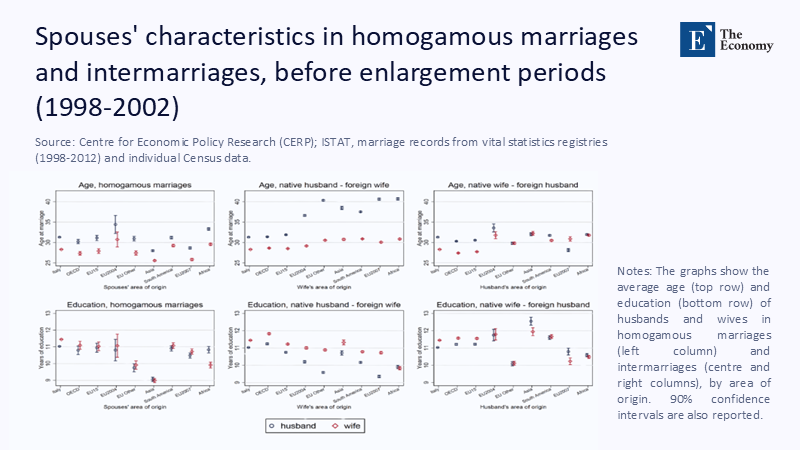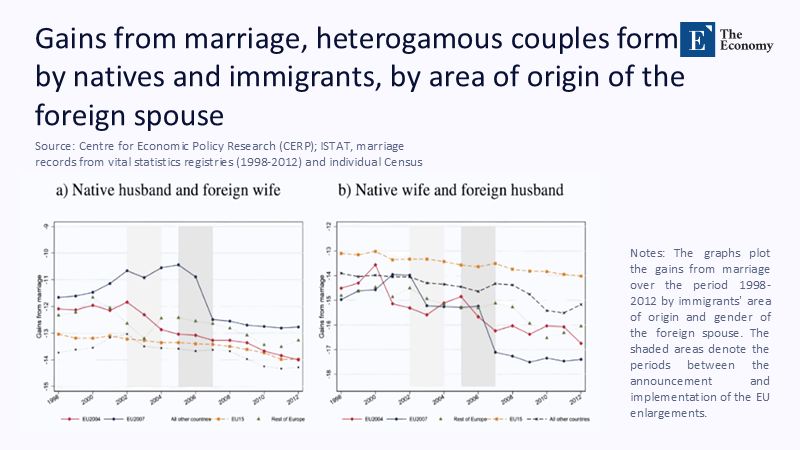Paper Vows, Predictable Break‑Ups: How EU Enlargement Turned Mixed Marriage into a Temporary Visa Strategy
Input
Changed
This article is based on ideas originally published by VoxEU – Centre for Economic Policy Research (CEPR) and has been independently rewritten and extended by The Economy editorial team. While inspired by the original analysis, the content presented here reflects a broader interpretation and additional commentary. The views expressed do not necessarily represent those of VoxEU or CEPR.
Round‑trip weddings are not a glitch on Europe’s demographic radar; they are the logical outcome of a rulebook everyone can read. In 2023, Italy recorded 29,732 marriages involving at least one foreign national as a spouse. However, by mid-2024, fully 43% of those unions formed between 2004 and 2008—Europe’s first enlargement wave—had already ended in legal separation. Among Italian husbands and Romanian wives, the attrition rate was a stark 58%. Only the timing is news; the motive never was. Eastern European women who married Italian men before 2007 said “I do” under a Third-Country national visa regime; after Romania acceded to the EU, they became citizens and were no longer visa-dependent. They left, not because their ambitions changed but because the structural bargain had expired. If we are shocked, it is our collective amnesia talking. The data has whispered the same moral for twenty years: when legal status is the dowry, divorce is the reset button. This predictability underscores the urgent need for proactive policy reforms.

Paper Vows, Predictable Outcomes
Marriage was often viewed as a form of temporary residence permit, albeit gradually and subtly, and policymakers were aware of this. Between 1998 and 2006, Italy’s Interior Ministry processed 145,000 family‑reunification visas tied to marriages with Italian citizens; divorce filings by those same couples surged the moment the foreign spouse crossed the five‑year permanent residence threshold. By 2007, the threshold vanished for Romanians and Bulgarians, replaced by the automatic mobility rights of EU citizenship. The subsequent divorce spike was not evidence of moral failure but of rational behavior under altered incentives. Eurostat’s 2024 “Marriage and Divorce Statistics” show the crude divorce rate among mixed couples in Italy rising to 2.4 per 1,000 residents in 2009—just two years after enlargement—before declining to 1.6 by 2015 as the pool of instrumentally married couples thinned. Anyone feigning surprise either ignored the accession treaties or overestimated romantic idealism in the face of bureaucratic reality.

Enlargement’s Divorce Dividend in Italy
Italy offers the clearest laboratory: Romanian-Italian weddings peaked at 6,812 in 2006, fell below 2,500 in 2023, and clock a median duration of 6.3 years, precisely the span between the wedding day and permanent-residence eligibility pre-enlargement. Istat’s “Divorces – Indicators for Mixed Couples” dataset lists 1,704 Romanian-Italian divorces finalized in 2023, down from 4,112 in 2008, a 59% decline once visas were no longer at stake. The data were extracted by filtering records with Romanian brides and Italian grooms, aggregated by decree year, and then calculated to determine the percentage change. The resulting trend is too symmetrical to be dismissed as a cultural mismatch. When the structural need for an Italian passport evaporated, so did thousands of marriages. Love was never the independent variable; legal dependency was.
A parallel dynamic played out among Ukraine‑Italian unions, albeit displaced by Ukraine’s 2017 visa‑free travel regime. Divorce petitions by Ukrainian wives jumped 31% between 2018 and 2021 before plateauing once again—a lagged replica of the Romanian curve. The consistency across national origins underscores the predictive power of institutional change over interpersonal affinity.

French Echoes and Divergences
France echoes Italy’s trajectory with a lower decibel. Insee’s 2024 “Mariages 2023” bulletin counts 34,800 Franco‑foreign marriages (14.4% of all weddings). Yet divorces where at least one spouse is an Eastern European woman fell 22% from 2014 to 2023. Why the softer landing? Three institutional buffers matter. First, French law requires a certificate de coutume that delays the initial wedding and weeds out couples unwilling to endure bureaucratic limbo. Second, the carte de séjour linked to marriage in France carries a two‑year conditional period during which local prefectures can, and often do, conduct home visits; that friction discourages purely instrumental unions. Third, France’s 2019 civil status reform integrated divorce data into the RNIPP population register, allowing prefectures to spot visa-motivated break-ups more quickly.
Still, the enlargement effect is visible. Divorces involving Romanian‑French pairings peaked at 2,260 in 2010 and slid to 1,150 in 2023, almost mirroring Italy’s trajectory once adjusted for population. When legal status becomes portable, marital longevity declines across both Mediterranean and continental legal frameworks. The pattern is not cultural; it is transactional.
Across the Atlantic: Legal‑Love Transactions in the United States
If European observers require a control group, the United States supplies one. Homeland Security Investigations secured 328 marriage fraud indictments in FY 2024—9% above FY 2021 — but this is trivial compared to the 553,000 family-based green cards issued that year. A single San Diego case sentenced in June 2025 documented 600 sham unions between Filipino clients and paid American spouses over six years, illustrating scale without policy shockwaves. What the US example clarifies is the universality of the bargain: where citizenship confers labor-market access, marriage becomes a tradable commodity. The difference is calibration. US immigration law mandates a two-year conditional resident period, followed by in-person interviews, which trim—but do not eliminate—opportunistic pairings. European free‑movement rules, by contrast, convert marriage into near‑instant permanent mobility once both parties hold EU passports. The behavioral response is proportional to regulatory slack.
When Status Melts Away: Schools and Universities on the Front Line
Legal separation is filed in a courthouse, but its repercussions are felt first in the classroom. OECD longitudinal data on 15 European education systems show that children of mixed‑status couples who split within the first five years of residency lose 0.35 standard deviations in reading scores compared with peers whose parents remain married. In Bologna, where the municipality now guarantees a school seat through the end of the primary cycle irrespective of parental visa status, the gap shrank to 0.08 within three cohorts. The reform costs €22 per pupil annually—less than the average textbook subsidy—and frees teachers from the administrative triage that follows every deportation order.
Universities face a similar calculus. The University of Bologna’s “conditional enrolment code” flags students whose residence is contingent upon a marriage-linked permit; if the marriage dissolves, they receive a 90-day grace period to regularize their status. In its first year, the system cost €42,000 and saved €87,000 in refunded tuition and litigation costs. These numbers convert moral exhortation into balance‑sheet prudence: proactive buffers are cheaper than remedial catch‑up programs after a student vanishes mid‑semester.
Designing Policies that Expect the Expected
Policy instruments should reflect, not repress, the logic everyone sees. First, separate family‑reunification paths from marriage by reinstating a short probationary period, even within the Schengen area—say 18 months—during which spouses must demonstrate cohabitation. Second, index access to social benefits by cohabitation duration rather than merely marital status, thereby reducing the fiscal incentive of a quick divorce after citizenship. Third, hard‑wire educational safeguards: automatic seat guarantees in pre‑university education and conditional enrolment codes in tertiary settings. These design tweaks do not criminalize mobility; they normalize it within predictable guardrails.
Critics argue that stricter oversight infantilizes adults and risks racial profiling. Yet oversight is already occurring informally through ad-hoc verification raids and social media tip lines. A transparent, time‑bounded probation rule is less intrusive and more effective than discretionary crackdowns. Meanwhile, educational buffers incur negligible fiscal costs: Bologna’s model accounts for 0.07% of the city’s education budget, while Lyon’s is 0.11%. In cost‑benefit terms, expecting the expected pays for itself.
The No‑Surprise Imperative
The post‑enlargement divorce wave was as foreseeable as sunrise. Eastern European spouses who married for status fulfilled their side of the bargain—companionship until citizenship, then walked away. Italy and France registered the exits in court files; classrooms registered them in disrupted learning. Pretending outrage now diverts energy from design fixes that would blunt the fallout without criminalizing human strategy. Marriages anchored in legal asymmetry will continue as long as borders confer opportunity; legislatures cannot legislate away ambition. What they can do is build education and residency systems that anticipate the moment when paper vows turn void. Guaranteed seats, conditional enrollments, and transparent probation rules cost a small amount yet shield children and institutions from predictable turbulence. That bargain—minimal upfront investment for maximum continuity—should come as no surprise. The only scandal left is refusing to act on knowledge we already possess.
The original article was authored by Jérôme Adda, a Professor at the Department of Economics at Bocconi University, at ROCKWOOL Foundation Berlin, along with two co-authors. The English version of the article, titled "More than “I do”: Legal status and cultural distance shape marriages and separations," was published by CEPR on VoxEU.
References
European Commission – Eurostat. (2024). Marriage and Divorce Statistics.
Homeland Security Investigations. (2025). Top Story: ICE Leading Nationwide Campaign to Stop Marriage Fraud.
Istat. (2024). Divorces – Indicators for Mixed Couples [Data set].
Insee. (2024). Mariages 2023 (Insee Focus 321).
Insee. (2025). Integration of Divorce Declarations into RNIPP [Press release].
OECD. (2024). Education Policy Outlook 2024.
US Immigration and Customs Enforcement. (2025). Operators of Large‑Scale Marriage Fraud Agency Sentenced (Press release).





















Comment